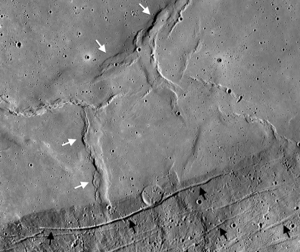
| Project Home | About the Scans | Browse Gallery | Image Map | Support Data | Resources | Ephemeris |
Featured Image - 01/18/2011
Structural Features in Southern Serenitatis
The mare basins were the centers of large-scale volcanic and tectonic activity on the Moon. Deep fractures in the lunar crust created by the tremendous energy released in the formation of the impact basin provided pathways for lava to make its way to the surface and flood the basin floor.
Figure 1. Apollo 17 metric frame showing
southern Mare Serenitatis (Apollo Image AS17-M-0451 [NASA/JSC/Arizona State University])
This impact-triggered volcanism set the stage for more geologic activity in the basins. Under the weight of the thick sequence of lava (mare basalt) that filled the mare basin, the lunar crust began to sag and subsided. This subsidence caused the volcanic fill to contract and buckle, forming wrinkle ridges. Some of the most prominent wrinkle ridges on the Moon are found in Mare Serenitatis (white arrows in figure below).
Figure 2. Annotated version of Figure 1,
highlighting geologic features in southern Mare Serenitatis (Apollo Image AS17-M-0451 [NASA/JSC/Arizona State University])
Wrinkle ridges are complex tectonic landforms often consisting of broad, low-relief arch-like features with superimposed narrower, tighter relief ridges. Wrinkle ridges in Mare Serenitatis form a distinct pattern, with some ridges oriented radial to the basin center and other ridges oriented concentric with the basin rim. The weight of the volcanic fill has another effect: it causes the lunar crust to flex and bend. This bending pulls the volcanic sequence apart near the edge of the basin where it brakes forming narrow troughs called rilles (black arrows). The narrow, extensional troughs in Mare Serenitatis, like the wrinkle ridges, also form a distinct pattern. The troughs are usually oriented concentric with the basin rim. The flooding of the impact basin by lava followed by subsidence and flexure forming contractional wrinkle ridges and extensional troughs in Mare Serenitatis is a geologic sequence of events seen in other lunar mare.
Tweet
|
|
Space Exploration Resources |
|
 LPI LPI
|

